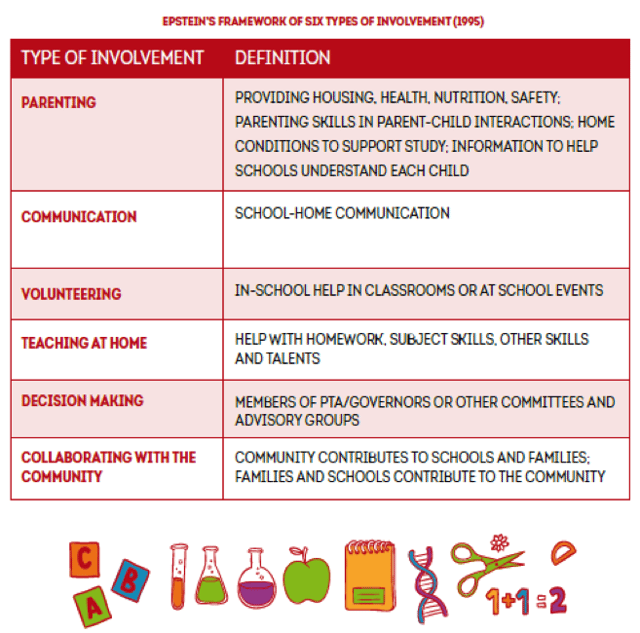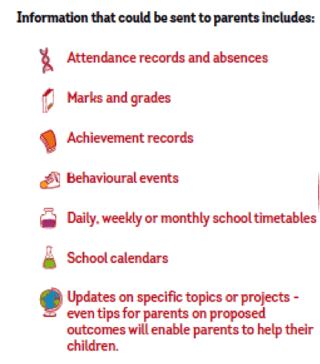10 Steps to Better Parental Involvement in Schools
There are many benefits to parental involvement in school activity, including improved grades, higher student attendance and better attitude and behaviour, towards both parents and teachers.
The school can benefit from parental engagement because more homework is completed to a higher standard, children bond better with teachers and there is less parent-teacher conflict, making it a better working environment and, in turn, helping to reduce staff turnover. As a result, teachers can focus more on positive aspects of school life and spend more time achieving and maintaining high standards in their school.
According to Professor John Hattie, when pursued consistently throughout a child’s development, parental engagement could amount to the equivalent of an additional two to three years’ schooling for a child, adding massively to their overall achievement.
[Source: The National]
The following 10 steps to support your own parental engagement strategy are from our comprehensive guide on parental engagement, ‘Exploring the Importance of Parental Engagement for Schools’. Download the full eBook for free today for practical advice on how to implement your engagement strategy with real examples from schools and parental engagement best practice.
Step One: Define and map the strategy
Many psychologists have studied the impact of parental involvement on children’s education. Epstein is one who contributed significantly to the topic by identifying six types of parental involvement.
Epstein’s framework is key to designing and analysing family engagement programmes, describing general categories of partnerships existing between schools, families and communities. To this day, many modern investigations into parental involvement rely on Epstein’s findings.

Use Epstein’s framework and tailor it to your school’s needs. Identify the key issues of staff and parents, then create a strategy to resolve them. Ensure results of the strategy can be measured so you know it’s effective.
Step Two: Implement the strategy internally
The senior leadership team is integral to the strategy’s success. These individuals need to help implement it effectively throughout the school, so it’s vital they understand the purpose of it.
In addition to the SLT, it’s crucial to get feedback from other staff within your school. The staff are responsible for implementing new technology and processes, as well as training new staff.
Teachers themselves will need to settle into a new way of working. As parental engagement is two-way, staff can be daunted by this, fearing this may cause extra work. The results are quite the opposite when new technologies are used to their full potential, however their concerns need to be heard and addressed to give them reassurance.
Step Three: Give parents regular, useful information about their child
A parental engagement strategy aims to open up communication channels between the school and parents. Information should be sent to parents frequently and in a way that is convenient for them.
Today, digital communication is considered to be more convenient for parents, and can be employed to allow additional opportunities for parents or guardians to connect with the school, such as invitations to PTA events.
Small efforts in breaking down home-school barriers can lead to big results, however in order to identify where to focus efforts, parents’ views should be listened to and any concerns must be addressed.
Step Four: Ensure parents understand the impact of parental involvement on their child's education as well as the role they should play
Parents are key to supporting learning outside the classroom. Studies have shown the strongest support for learning occurs through positive parenting styles, nightly reading and setting expectations for homework and grades.
Parents’ understanding of the school’s approach and how vital they are to their child’s education is crucial to ensure your strategy’s success.
Teachers can make a significant impact by giving detailed information on which topics pupils need help on, as well as providing support and guidance for parents.
Step Five: Give parents the confidence to teach their own children
60% of parents want to be more involved in their child’s learning, however may not think they have the knowledge needed to teach their child correctly, so they don’t.
Giving parents actionable advice will help them to become more effective in their child’s education.
Step Six: Give the pupil the opportunity to shape their own education
This unconventional approach helps unify communications between the pupil, parent and teacher. If the parent speaks to the child and the school, they are bound to hear different stories. Rather than having isolated conversations, invite parents and pupils to discuss the pupil’s progress together.
This gives the child the opportunity to take responsibility for their learning and identifies weaker areas, which the parent can help support. In running such sessions, the school is providing a space for parents and children to bond, with the parent visibly and actively interested in their child’s progress.
Step Seven: Ensure parents feel their voices are heard
Parents respond better when they feel like they have an important role to play. Give them the opportunity to voice their opinions and then act upon it. Showing that you’re listening to parents’ concerns will help reduce any frustrations they may have, build trust and spread positive sentiment.
Step Eight: Minimise barriers hindering parent-teacher engagement
Parents may be experiencing personal obstacles preventing them from engaging fully with the school, such as language barriers, time constraints, money or transport issues, which can be detrimental to parent-teacher communication.
These barriers should be identified and understood and solutions sought to address them wherever possible. For example Groupcall Messenger can broadcast messages in 64 different languages, ensuring everyone can be included in routine and emergency communications without the need for time-consuming manual translations.
Step Nine: Be flexible
Like students, every parent is different in terms of their communication preference, working hours and commitment to their child’s learning. One of the key features of your strategy is that it needs to be flexible to suit parents’ needs.
This should be taken into account when sending out communications and meetings, which should be broadcast utilising a variety of channels.
Step Ten: Continue analysing and refining
Holding regular reviews with staff and parents will give you the feedback you need to fine-tune your strategy. Setting measurable goals will help demonstrate improvement, which then can be used to motivate more parents and stakeholders to get involved.
Improving parental engagement presents challenges and may be time consuming initially, but the benefits of helping to strengthen bonds between educators, parents and children are obvious and significant.
Download the full eBook, ‘Exploring the Importance of Parental Engagement for Schools’, for more detailed research into the benefits of parental engagement, and tips on how to implement your engagement strategy, with real life examples from schools.
 |
Andrew Mulholland has worked in education since the late 90s. He joined Groupcall in early 2016 as part of the company’s senior management team. |



